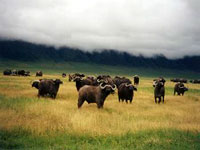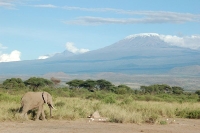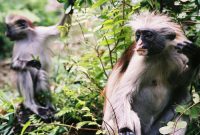Things to do in National Parks and Reserves
The Serengeti National Park, Ngorongoro Conservation Area, and Mount Kilimanjaro National Park are all well known to foreigners as prime safari destinations, but Tanzania has much to offer beyond this renowned Northern Safari Circuit.
Many lesser-known gems invite repeat visits to the country for nature and animal lovers. There are in fact 15 national parks in Tanzania, and a further 15 game reserves and protected wilderness areas, ensuring that vast swathes of this beautiful country remain in pristine natural condition.
For those seeking out chimpanzees rather than the Big Five, the Gombe Stream and Mahale Mountains National Parks that border Lake Tanganyika in western and central Tanzania are the best bet.
Ruaha National Park, Tanzania's largest, is home to a large population of elephants and is a good option for adventurers wanting to get off the beaten track and experience a true, rugged wilderness seemingly devoid of people.
The Selous Game Reserve of southern Tanzania is also vast and also feels delightfully empty of humankind, offering a large variety of game, including impressive numbers of the seriously endangered wild dog.
Hikers who prioritise landscape over wildlife would do well to visit the biodiverse paradise of Udzungwa Mountains National Park, in central Tanzania, which promises glorious trekking opportunities.
Those spending time in Zanzibar will find the Jozani-Chwaka Bay National Park a wonderful place for bird and butterfly viewing, not to mention seeking out the odd-looking red colobus monkeys that call the island home.
Serengeti National Park
Meaning 'endless plains' in the Masai language, the Serengeti is Tanzania's oldest park and one of the world's best wildlife refuges, continuous with Kenya's Masai Mara Game Reserv…
Serengeti National Park
Meaning 'endless plains' in the Masai language, the Serengeti is Tanzania's oldest park and one of the world's best wildlife refuges, continuous with Kenya's Masai Mara Game Reserve to the north. The open plains are home to an estimated three million large mammals that are involved in seasonal migration, and have the largest concentration of wildlife in the world if the figure includes the population of birds and smaller animals. The Serengeti is famous for the Great Migration, possibly the most astounding occurrence in the animal kingdom that's known to humankind. During this time, millions of hoofed animals, predominantly wildebeest, form one massive herd and leave the dry plains of Tanzania in search of greener grazing and water to the north. Bringing up the rear of the procession are the weak, the young, and the crippled, followed closely by large numbers of vigilant predators, including lions, cheetahs, hyenas, and wild dogs.
Website www.serengeti.org

Ngorongoro Conservation Area
Rising above the plains of the Serengeti, the Ngorongoro Conservation Area is a vast, UNESCO-listed protected area that includes the important archaeological site of Olduvai Gorge …
Ngorongoro Conservation Area
Rising above the plains of the Serengeti, the Ngorongoro Conservation Area is a vast, UNESCO-listed protected area that includes the important archaeological site of Olduvai Gorge and its main attraction, the Ngorongoro Crater. Once the site of an active volcano, the crater was formed about two million years ago when its cone collapsed on itself. Today the crater floor, supplied with permanent water and ringed with towering forested sides, serves as a natural cradle for an astounding abundance of wildlife. With an incredible width of 12 miles (20km) and a depth of 2,001ft (610m), the crater is the largest caldera in the world and is home to tens of thousands of animals, including rhino, buffalo, and large herds of zebra and wildebeest. There are also dense concentrations of predators attracted by the large variety of grazers, and prides of lion with magnificent black-maned males are one of the highlights.

Mount Kilimanjaro National Park
Rising 19,341ft (5,895m) above the African plains, the magnificent solitary peak of Mount Kilimanjaro is the dominant feature of this national park. The lush rainforest on its lowe…
Mount Kilimanjaro National Park
Rising 19,341ft (5,895m) above the African plains, the magnificent solitary peak of Mount Kilimanjaro is the dominant feature of this national park. The lush rainforest on its lower slopes is home to a number of animals including elephant, buffalo, rhino, monkey, and leopard. Its dormant volcano is remarkable in many ways, not only for its snow-covered peaks and glaciers rising out of a humid equatorial jungle, but also because it's the highest freestanding mountain in the world, a huge cone unattached to a mountain range, and Africa's highest peak. Its magnetism has attracted researchers, mountaineers, and adventurers for years. It's the only mountain of its size that can be scaled by inexperienced hikers, although altitude sickness is common and can be fatal. There are six different routes of varying degrees of difficulty, but the easiest and most popular way to reach the summit is on the Marangu Trail, which takes about five days, with nights spent in huts along the way.
Website www.tanzaniaparks.go.tz

Udzungwa Mountains National Park
Said to be the most biodiverse national park in Tanzania, Udzungwa Mountains National Park is less a magnet for game viewing than for hiking. A network of forest trails crisscrosse…
Udzungwa Mountains National Park
Said to be the most biodiverse national park in Tanzania, Udzungwa Mountains National Park is less a magnet for game viewing than for hiking. A network of forest trails crisscrosses the peaks and offers treks to hidden waterfalls and majestic vistas. A popular hike is the half-day trip to Sanje Waterfall, while the two-day hike along Mwanihana Trail provides panoramic views of the surrounding valleys. Visitors can also hike to cultural and historical sites such as the Mwanaruvele and Magombereka Caves. While Udzungwa Mountains National Park isn't known for its game, there are still plenty of exotic animals to spot, including birds, mammals, reptiles, amphibians, butterfly, and other creatures. The Iringa Red Colobus Monkey, and the Sanje-Crested Mangebay, both found only in Tanzania, can be spotted in the park.



